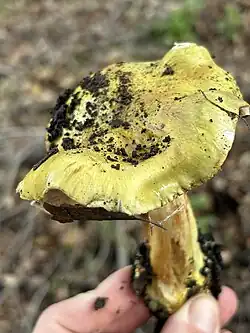Calonarius viridirubescens
| Calonarius viridirubescens | |
|---|---|

| |
| San Luis Obispo County, California, 2022 | |
| Scientific classification | |
| Kingdom: | Fungi |
| Division: | Basidiomycota |
| Class: | Agaricomycetes |
| Order: | Agaricales |
| Family: | Cortinariaceae |
| Genus: | Calonarius |
| Species: | C. viridirubescens
|
| Binomial name | |
| Calonarius viridirubescens (M.M. Moser & Ammirati) Niskanen & Liimat. (2022)
| |
| Synonyms | |
|
Cortinarius viridirubescens | |
| Calonarius viridirubescens | |
|---|---|
| Gills on hymenium | |
| Cap is convex | |
| Hymenium is emarginate | |
| Stipe has a cortina | |
| Spore print is reddish-brown | |
| Ecology is mycorrhizal | |
| Edibility is unknown | |
Calonarius viridirubescens is a species of gilled mushroom. First described to science in 1997,[1] this species was previously classified as Cortinarius viridirubescens,[2] and is thus commonly known as the yellow-green cort.[3]
This California endemic mushroom's coloration is distinctive, with a chartreuse stipe to go with its yellow-green cap (the color can range from grass green to rusty orange).[3] This mushroom has the "enlarged" bulb at the base that is typical of cortinarias, stains red in age, and according to the authors of Mushrooms of the Redwood Coast, has a "prominent cobwebby cortina of whitish yellow to light greenish yellow fibers over much of cap and stipe when young" but this feature is "ephemeral and often absent at maturity."[3]
Typically found in oak woodlands, the fruiting triggers and edibility of the yellow-green calonarius remain undescribed.[3]
References
- ^ "M.M. Moser & Ammirati, Sydowia 49 (1): 44 (1997)" (PDF).
- ^ Liimatainen, Kare; Kim, Jan T.; Pokorny, Lisa; Kirk, Paul M.; Dentinger, Bryn; Niskanen, Tuula (January 2022). "Taming the beast: a revised classification of Cortinariaceae based on genomic data". Fungal Diversity. 112 (1): 89–170. doi:10.1007/s13225-022-00499-9. hdl:2299/25409. ISSN 1560-2745.
- ^ a b c d Siegel, Noah; Schwarz, Christian (2016). Mushrooms of the Redwood Coast: A Comprehensive Guide to the Fungi of Coastal Northern California. Clarkson Potter/Ten Speed. p. 193. ISBN 9781607748182. LCCN 2015027853. OCLC 956478776.